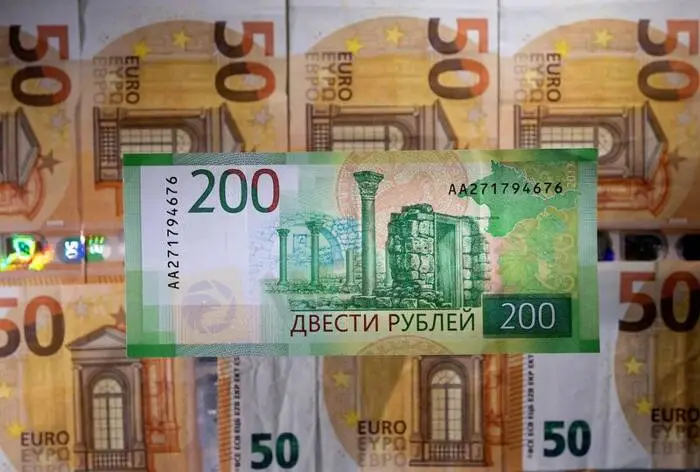简体中文
繁體中文
English
Pусский
日本語
ภาษาไทย
Tiếng Việt
Bahasa Indonesia
Español
हिन्दी
Filippiiniläinen
Français
Deutsch
Português
Türkçe
한국어
العربية
Russian rouble leaps to near 7-year high vs euro
Abstract:The Russian rouble strengthened on Monday, heading back towards multi-year highs hit against the dollar and euro last week, supported by capital controls and an upcoming month-end tax period.
The Russian rouble firmed more than 6% against the euro on Monday to a near seven-year high, boosted by capital controls, strong oil prices and an upcoming month-end tax period.
By 1338 GMT, the rouble had gained 6.3% to trade at 58.75 versus the euro, its strongest point since early June 2015.

It was 4.6% stronger against the dollar at 57.47, not far from 57.0750, its strongest mark since late March 2018, hit on Friday.
The rouble has firmed about 30% against the dollar this year despite a full-scale economic crisis in Russia, making it the – albeit artificially supported by controls imposed in late February to shield Russias financial sector after its decision to send tens of thousands of troops into Ukraine prompted unprecedented Western sanctions.
The rouble is being driven by export-focused companies that are obliged to convert their foreign currency revenue after the sanctions froze nearly half of Russias gold and forex reserves.
While the central bank and government leave restrictions in place, the rouble could continue to strengthen further in the medium term, said Tinkoff Investments analysts.
“Closer to autumn, the exchange rate may start to stabilise nearer to the 60-65 level as imports recover and restrictions are potentially lifted.”
Otkritie Bank analysts said the rouble may firm to 55 to the dollar within a month before weakening to 70-80 by year-end.
Russian demands that foreign buyers pay for gas in roubles has also contributed to the roubles recent rally, analysts said last week.
The supply of foreign currency from exporters, high oil prices and an upcoming month-end tax period that usually prompts export-focused companies to convert their forex revenues into roubles to meet local liabilities are all supporting the Russian currency, said BCS Express in a note.
CENTRAL BANK INTERVENTIONS?
The Vedomosti daily reported on Monday, citing sources, that the central bank had started purchasing foreign currency in order to stop the roubles uncontrolled strengthening.
The central bank denied the report, saying “this information does not correspond to reality”.
If the central bank were carrying out such interventions, the effect on the rouble rate would be more noticeable, said Promsvyazbank analysts.
“Nevertheless, such news could influence the behaviour of market participants and provoke a weakening of the rouble.”
Russian stock indexes were mixed.
The dollar-denominated RTS index was up 2.2% to 1,266.8 points. The rouble-based MOEX Russian index was 2.6% lower at 2,311.2 points.
(Reporting by Reuters Editing by William Maclean, Mark Potter and Toby Chopra)
Disclaimer:
The views in this article only represent the author's personal views, and do not constitute investment advice on this platform. This platform does not guarantee the accuracy, completeness and timeliness of the information in the article, and will not be liable for any loss caused by the use of or reliance on the information in the article.
WikiFX Broker
Latest News
What Makes Cross-Border Payments Easier Than Ever?
Trader Exposes Unethical Practices by STP Trading
Saxo & Portuguese Bank Partnership
SEC Fines Broker-Dealers $275K for Incomplete SAR Filings
Lured by False Promises: Malaysian Driver Lost RM218K to an Investment Scam
FTX Sets March 2025 Timeline for Creditor Payouts: What It Means for Investors
What is an Economic Calendar? How it works
Italian Regulator Warns Against 5 Websites
Mastercard's 2030 Vision: Biometric-Driven, Tokenized Payments
SFC Freezes $91M in Client Accounts Amid Fraud Probe
Currency Calculator


